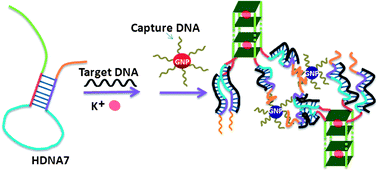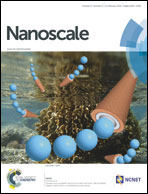Architecture based on the integration of intermolecular G-quadruplex structure with sticky-end pairing and colorimetric detection of DNA hybridization†
Abstract
An interesting discovery is reported in that G-rich hairpin-based recognition probes can self-assemble into a nano-architecture based on the integration of an intermolecular G-quadruplex structure with the sticky-end pairing effect in the presence of target DNAs. Moreover, GNPs modified with partly complementary DNAs can intensively aggregate by hybridization-based intercalation between intermolecular G-quadruplexes, indicating an inspiring assembly mechanism and a powerful colorimetric DNA detection. The proposed intermolecular G-quadruplex-integrated sticky-end pairing assembly (called GISA)-based colorimetric system allows a specific and quantitative assay of p53 DNA with a linear range of more than two orders of magnitude and a detection limit of 0.2 nM, suggesting a considerably improved analytical performance. And more to the point, the discrimination of single-base mismatched target DNAs can be easily conducted via visual observation. The successful development of the present colorimetric system, especially the GISA-based aggregation mechanism of GNPs is different from traditional approaches, and offers a critical insight into the dependence of the GNP aggregation on the structural properties of oligonucleotides, opening a good way to design colorimetric sensing probes and DNA nanostructure.


 Please wait while we load your content...
Please wait while we load your content...